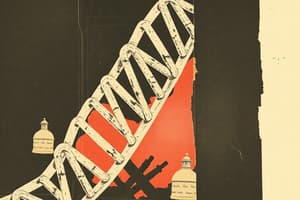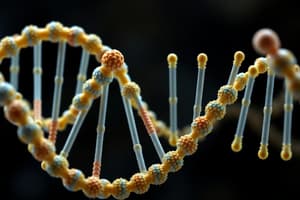Podcast
Questions and Answers
Describe how the structure of DNA was discovered.
Describe how the structure of DNA was discovered.
The discovery of the structure of DNA had many false starts until the correct structure was discovered in 1953. James Watson and Francis Crick have been credited with the discovery of the structure of DNA, using an x-ray photograph taken by Rosalind Franklin.
Who should be credited with the discovery of DNA?
Who should be credited with the discovery of DNA?
James Watson and Francis Crick are credited with the discovery, but Rosalind Franklin and Maurice Wilkins significantly contributed by capturing images of the molecule.
Discuss the contributions that women have made in science.
Discuss the contributions that women have made in science.
Rosalind Franklin studied DNA using x-rays; Jane Goodall studied chimpanzees; Marie Curie was the first female scientist to win a Nobel Prize; Lise Meitner discovered protactinium; Barbara McClintock won a Nobel Prize for discovering that genetic information isn't stationary.
Define: DNA replication, heredity, DNA helix, and semi-conservative.
Define: DNA replication, heredity, DNA helix, and semi-conservative.
Identify the components of a nucleotide.
Identify the components of a nucleotide.
Explain the role of DNA in the body.
Explain the role of DNA in the body.
Outline the process of DNA replication.
Outline the process of DNA replication.
Compare DNA and RNA.
Compare DNA and RNA.
Flashcards are hidden until you start studying
Study Notes
Discovery of DNA Structure
- The correct structure of DNA was identified in 1953 after several failed attempts.
- James Watson and Francis Crick are credited with discovering the DNA structure.
- They utilized an X-ray photograph taken by Rosalind Franklin to uncover the double helix structure.
- Watson and Crick constructed the first model of DNA, revealing the nucleotide unit's arrangement.
Credit for Discovery of DNA
- A debated topic regarding credit for the discovery of DNA's structure.
- Watson and Crick are known for determining the structure, while Franklin and Maurice Wilkins contributed vital images of DNA.
- Rosalind Franklin's photographic work was crucial to the breakthrough in understanding DNA.
Contributions of Women in Science
- Rosalind Franklin (1920-1958):
- Used X-ray crystallography to study DNA.
- Her work led to the discovery of the DNA structure.
- Jane Goodall (1934-present):
- Renowned primatologist who studied chimpanzees in Tanzania.
- Made significant discoveries about chimpanzee behavior, including tool use and meat consumption.
- Marie Curie (1867-1934):
- First woman to win a Nobel Prize in Physics and the only one to win two Nobel Prizes in different scientific fields.
- Researched radiation and discovered elements polonium and radium; known for her cancer research contributions.
- Lise Meitner (1879-1968):
- Physicist who, with Otto Hahn, co-discovered protactinium.
- Barbara McClintock (1902-1992):
- Discovered that genetic information is not fixed, challenging previous notions of genetics.
- Her groundbreaking work was later recognized with a Nobel Prize in Medicine.
Key Definitions
- DNA Replication: The process by which DNA makes a copy of itself before cell division.
- Heredity: The passing of genetic traits from one generation to the next.
- DNA Helix: The twisted ladder structure that DNA forms, characterized by two strands coiled around each other.
- Semi-Conservative: Describes the DNA replication process where each new DNA molecule retains one original strand and one newly synthesized strand.
Components of a Nucleotide
- Nucleotides consist of three parts: a phosphate group, a sugar molecule (deoxyribose for DNA), and a nitrogenous base (adenine, thymine, cytosine, or guanine).
Role of DNA in the Body
- DNA carries the genetic instructions for the development, functioning, growth, and reproduction of all known organisms.
- It directs protein synthesis, which plays crucial roles in biological processes.
Process of DNA Replication
- The two DNA strands separate.
- Each strand serves as a template for synthesizing a new complementary strand.
- DNA polymerase plays a key role in adding nucleotides to form new strands.
Comparison of DNA and RNA
- DNA (deoxyribonucleic acid): Double-stranded, contains deoxyribose sugar, and uses thymine as a base.
- RNA (ribonucleic acid): Single-stranded, contains ribose sugar, and uses uracil instead of thymine.
Studying That Suits You
Use AI to generate personalized quizzes and flashcards to suit your learning preferences.





